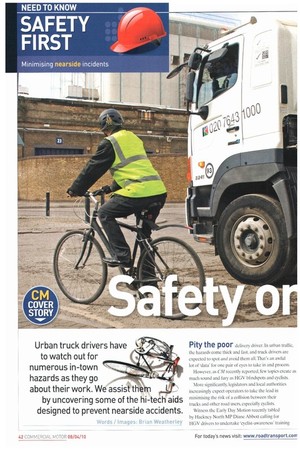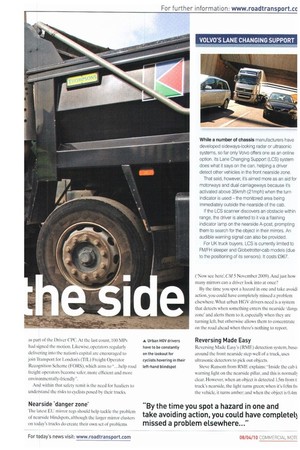Urban truck drivers have to watch out for numerous in-town
Page 42

Page 43

Page 44

If you've noticed an error in this article please click here to report it so we can fix it.
hazards as they go about their work. We assist them by uncovering some of the hi-tech aids designed to prevent nearside accidents.
Words Images: Brian WeatherLey Pity the poor delivery driver. In urban traffic, the hazards come thick and fast, and truck drivers are expected to spot and avoid them all. Thai's an awful lot of 'data' for one pair of eyes to take in and process.
However, as CM recently reported, few topics create as much sound and fury as HGV blindspots and cyclists.
More significantly, legislators and local authorities increasingly expect operators to take the lead in minimising the risk of a collision between their trucks and other road users, especially cyclists.
Witness the Early Day Motion recently tabled by Hackney North MP Diane Abbott calling for HGV drivers to undertake "cyclist-awareness' training as part of the Driver CPC. Al the last count, 100 MPs had signed the motion. Likewise, operators regularly delivering into the nation's capital are encouraged to join iransport for London's (TfL) Freight Operator Recognition Scheme (FORS), which aims to "...help road freight operators become safer, more efficient and more environmentally-friendly".
And within that safety remit is the need for hauliers to understand the risks to cyclists posed by their trucks.
Nearside 'danger zone' 'the latest Lt... mirror regs should help tackle the problem of nearside hlindspots, although the larger mirror clusters on today's trucks do create their own set of problems
While a number of chassis manufacturers have developed sideways-looking radar or ultrasonic systems, so far only Volvo offers one as an online option, Its Lane Changing Support (LCS) system does what it says on the can, helping a driver detect other vehicles in the front nearside zone.
That said however, it's aimed more as an aid for motorways and dual carriageways because it's activated above 35km/h (21mph) when the turn indicator is used — the monitored area being immediately outside the nearside of the cab.
If the LCS scanner discovers an obstacle within range, the driver is alerted to it via a flashing indicator lamp on the nearside A-post, prompting them to search for the object in their mirrors. An audible warning signal can also be provided.
For UK truck buyers, LCS is currently limited to FM/FH sleeper arid Globetrotter-cab models (due to the positioning of its sensors). It costs E967, (*Now see here; CM 5 November 2009). And just how many mirrors can a driver look into at once?
By the time you spot a hazard in one and take avoidi action, you could have completely missed a problem elsewhere. What urban HGV drivers need is a system that detects when something enters the nearside 'dangt zone' and alerts them to it. especially when they are turning left, hut otherwise allows them to concentrate on the road ahead when there's nothing to report.
Reversing Made Easy
Reversing Made Easy's ( RME) detection system, base' around the front nearside step-well of a truck, uses ultrasonic detectors to pick out objects.
Steve Ransom from RME explains: "Inside the cab i: warning light on the nearside pillar, and this is normal!! clear. However, when an object is detected 1.5m from tl truck's nearside, the light turns green: when it's 0.8m frc the vehicle, it turns amber; and when the object is 0.4m from the truck. it turns red and the driver gets an audible warning,.The lamp is located in such a way as to draw the driver's attention to his nearside and his mirror.
Rather than being activated by the turn indicator, the RME system remains 'vigilant' all the time it can't be turned off by the driver. However. Ransom stresses:
We can adjust the system to suit whatever parameters an operator wants. We can have the small lamp and the beeper, or a larger LED lamp, but without an alarm.
Up to speed
The basic RME front step system costs E149, which includes three sensors (extra sensors cost Lit)) as well as 'Speedswitch' that shuts off the sensors at 10km/h (7mpli), as Ransom asseris:"Aboye that speed, a driver wouldn't be able to stop in time anyway. Drivers don't want to be going down the road with something beeping all the time either. They need to know when there's immediate danger' According to Ransom: 'Anybody can install it, although most of our customers have it installed by their PDI dealer. It can be done in just under an hour."
He adds:"What's important is that the sensors' software has been specifically designed for HG Vs."
Among the customers for RME's front step system are DHL and Sainsbury's.
Interestingly. while Ransom says the system can he linked to an external warning, he says: "While it would tell a pedestrian a truck was turning, we conducted a lot of research and found that many cyclists wear MP3 players and they wouldn't hear we think it's far better to alert the [truck] driver." •








































































































































